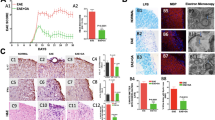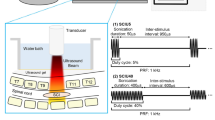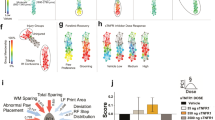Abstract
Gallium (Ga) nitrate has been shown to attenuate immune-mediated tissue destruction in models of neurological autoimmunity. Based upon these observations, we evaluated the efficacy of Ga nitrate in attenuating the inflammatory response and modifying clinical recovery in an experimental model of traumatic spinal cord injury (SCI). Using a randomized, double-blind, placebo-controlled design, 12 adult female Spraque-Dawley rats received injections of either Ga nitrate (n = 8) or saline (n = 4) following experimental SCI. Ga treated animals received 30 mg/kg elemental Ga followed by weekly injections of 10 mg/kg elemental Ga. There were no observable differences between the Ga treated and the saline control groups using various behavioral paradigms examined during the study period. Histological and immunocytochemical data qualitatively showed no observable differences between Ga treated (n = 4) and control (n = 2) groups sacrificed 18 days following SCI. Although the efficacy of Ga in this pilot study of experimental SCI was not demonstrated, the potential of Ga to attenuate inflammatory-mediated reactions remains an exciting possibility in the area of SCI. Our preliminary results should not discourage future research endeavors in this regard. A more complete analysis of dose response, time and mode of Ga administration (preinjury or postinjury), and availability of Ga across the blood-brain barrier is needed to further evaluate the efficacy of this compound.
Similar content being viewed by others
Log in or create a free account to read this content
Gain free access to this article, as well as selected content from this journal and more on nature.com
or
References
Young W (1993) Strategies for the development of new and better pharmacological treatments for acute spinal cord injury. Adv Neurol 59: 249–256.
Blight A R (1993) Remyelination, revascularization, and recovery of function in experimental spinal cord injury. Adv Neurol 59: 91–104.
Blight A R (1991) Morphometric analysis of a model of spinal cord injury in guinea pigs, with behavioral evidence of delayed secondary pathology. J Neurol Sci 103: 156–171.
Blight A R (1985) Delayed demyelination and macrophage invasion: a candidate for secondary cell damage in spinal cord injury. CNS Trauma 2: 299–315.
Ford R W J, Malm D N (1985) Failure of nimodipine to reverse acute experimental spinal cord injury. CNS Trauma 2: 9–16.
Hedeman L S, Sil R (1974) Studies in experimental spinal cord trauma. Part 2. Comparison treatment with steroids, low-molecular weight dextran and catecholamine blockage. J Neurosurg 40: 44–51.
De La Torre J C, Johnson C M, Goode D J, Mullan S (1975) Pharmacologic treatment and evaluation of permanent experimental spinal cord trauma. Neurology (Minneapolis) 25: 508–514.
Guth L, Albuquerque E X, Deshpande S S, Barrett C P . Donati E J, Warnick J E (1980) Ineffectiveness of enzyme therapy on regeneration in the transected spinal cord of the rat. J Neurosurg 52: 73–86.
Ford R W J, Malm D N (1984) Failure of tetracaine to reverse spinal cord injury in the cat. J Neurosurg 60: 1269–1274.
Bracken M B, Shepard M J, Collins W F, Holford T R, Young W, Baskin D S et al (1990) A randomized, controlled trial of methylprednisolone or naloxone in the treatment of acute spinal-cord injury: results of the Second National Acute Spinal Cord Injury Study. N Engl J Med 322: 1405–1411.
Geisler F H, Dorsey F C, Coleman W P (1991) Recovery of motor function after spinal-cord injury—A randomized, placebo-controlled trial with GM-1 ganglioside. N Engl J Med 324: 1829–1838.
Hsu C Y, Dimitrijevic M R (1990) Methylprednisolone in spinal cord injury: the possible mechanism of action. J Neurotrauma 7: 115–119.
Matkovic V, Balboa A, Clinchot D, Whitacre C, Zwilling B, Brown D et al (1991) Gallium prevents adjuvant arthritis in rats and interferes with macrophage/T-cell function in the immune response. Curr Ther Res 50: 255–267.
Matkovic V, Gerber N, Brown D, Apseloff G, Zwilling B S (1991) Differential effect of gallium on MHC Class II expression by murine macrophages. FASEB J A1206: 4845.
Whitacre C, Apseloff G, Cox K, Matkovic V, Jewell S, Gerber N (1992) Suppression of experimental autoimmune encephalomyelitis by gallium nitrate. J Neuroimmunol 39: 175–182.
Collery P h, Rinjard P, Pechery C (1990) Effect of gallium chloride on inflammation and experimental polyarthritis. In: Collery Ph, Poirier LA, Manfait M, Etienne JC, editors. Metal Ions in Biology and Medicine. John Libbey Eurotext, Paris: 443–444.
Stokes B T, Noyes D H, Behrmann D L (1992) An electromechanical spinal injury device with dynamic sensitivity. J Neurotrauma 9: 187–195.
Beattie M S, Stokes B T, Bresnahan J C (1988) Experimental spinal cord injury: strategies for acute and chronic intervention based on anatomic, physiologic, and behavioral studies. In: Stein DG, Sabel BA, editors. Pharmacological Approaches to the Treatment of Brain and Spinal Cord Injury. Plenum Publishing Corp, New York: 43–74.
Stokes B T, Reier P J (1992) Fetal grafts alter chronic behavioral outcome after contusion damage to the adult rat spinal cord. Exp Neurol 116: 1–12.
Bresnahan J C, Beattie M S, Stokes B T, Conway K M (1991) Three-dimensional computer-assisted analysis of graded contusion lesions in the spinal cord of the rat. J Neurotrauma 8: 91–101.
Bresnahan J C, Beattie M S . Todd F, Noyes D H (1987) A behavioral and anatomical analysis of spinal cord injury produced by a feedback-controlled impaction device. Exp Neurol 95: 548–570.
Tarlov I (1957) Spinal Cord Compression: Mechanisms of Paralysis and Treatment. Charles C Thomas. Springfield, IL.
Rivlin A, Tator C (1977) Objective clinical assessment of motor function after experimental spinal cord injury in the rat. J Nenrosurg 47: 577–581.
Somerson S K, Stokes B T (1987) Functional analysis of an electromechanical spinal cord injury device. Exp Neurol 96: 82–96.
De Sousa B N, Horrocks L A (1979) Development of rat spinal cord. 1. Weight and length with a method for rapid removal. Dev Nenrosci 2: 115–121.
McMaster W R, Williams A F (1979) Identification of la glycoproteins in rat thymus and purification from rat spleen. Eur J Immunol 9: 426–433.
Johnson G S (1981) Clinical applications of gallium in oncology, hit J Nucl Med Biol 8: 249–255.
Hoffer P B (1981) Use of gallium-67 for detection of inflammatory diseases, Int J Nucl Med Biol 8: 243–247.
Foster B J, Clagett-Carr K . Hoth D . Leyland-Jones B (1986) Gallium nitrate: the second metal with clinical activity. Cancer Treat Rep 70: 1311–1319.
Warrell R P, Isreal R . Frisone M . Snyder T . Gaynor J J . Bockman R S (1988) Gallium nitrate for acute treatment of cancer-related hypercalcemia: a randomized, double-blind comparison to calcitonin. Ann Intern Med 108: 669–674.
Warrell R P . Skelos A . Alcock N W . Bockman R S (1986) Gallium nitrate for acute treatment of cancer-related hypercalcemia: clinicopharmacological and dose response analysis. Cancer Res 46: 4208–4212.
Kelsen D P . Alcock N . Yeh S . Brown J . Young C (1980) Pharmacokinetics of gallium nitrate in man. Cancer 46: 2009–2013.
Bockman R, Adelman R, Donnelly R . Brody L . Warrell R, Jones K ( 1990) Gallium a unique anti-resorptive agent in bone: pre-clinical studies on its mechanisms of action. In: Collery Ph. Poirer LA. Manfait M, Etienne JC. editors. Metal Ions in Biology and Medicine. John Libbey Eurotext, Paris: 426–431.
Hall T J, Chambers T J (1990) Gallium inhibits bone resorption by a direct effect on osteoclasts. Bone Mineral 8: 211–216.
Matkovic V, Apseloff G, Shepard D R . Gerber N (1990) Use of gallium to treat Paget's disease of bone: A pilot study. Lancet 335: 72–75.
Warrell R P, Alcock N W, Bockman R S (1987) Gallium nitrate inhibits accelerated bone turnover in patients with bone metastases. J Clin Oncol 5: 292–298.
Kovar J, Seligman P, Gelfand E W (1990) Differential growth-inhibitory effects of gallium on B-lymphocyte lines in high versus low iron concentration. Cancer Res 50: 5727–5730.
Blight A R (1991) Morphometric analysis of blood vessels in chronic experimental spinal cord injury: hypervascularity and recovery of function. J Neurol Sci 106: 158–174.
Streit W J, Graeber M B, Kreutzberg G W (1988) Functional plasticity of microglia: a review. Glia 1: 301–307.
Chitamber C R, Matthaeus W G, Antholine W E . Graff K, O'Brien W J (1988) Inhibition of leukemic HL60 cell growth by transferrin-gallium: effects on ribonucleotide reductase and demonstration of drug synergy with hydroxyurea. Blood 72: 1930–1936.
Hedley D W, Tripp E H, Slowiaczek P . Mann G J (1988) Effect of gallium on DNA synthesis by human T-cell lymphoblasts. Cancer Res 48: 3014–3018.
Larson S M, Rasey J S, Allen D R, Nelson N J . Grunbaum Z, Harp G D, Williams D L (1980) Common pathway for tumor cell uptake of Ga-67 and Fe-59 via a transferrin receptor. J Natl Cancer Inst 64: 41–53.
Andreesen R, Sephton R G, Gadd S, Atkins R C . De Abrew S (1988) Human macrophage maturation in vitro: expression of functional transferrin binding sites of high affinity. Blut 57: 77–83.
Author information
Authors and Affiliations
Rights and permissions
About this article
Cite this article
Colachis, S., Popovich, P. & Stokes, B. Gallium nitrate and spinal cord injury. A pilot study of efficacy using an experimental model. Spinal Cord 32, 86–92 (1994). https://doi.org/10.1038/sc.1994.15
Issue date:
DOI: https://doi.org/10.1038/sc.1994.15



